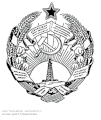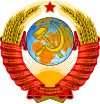
The Emblem of the Armenian Soviet Socialist Republic was devised from an initial prototype sketch by Martiros Saryan, a famous Armenian painter, and was adopted in 1937 by the government of the Armenian SSR.
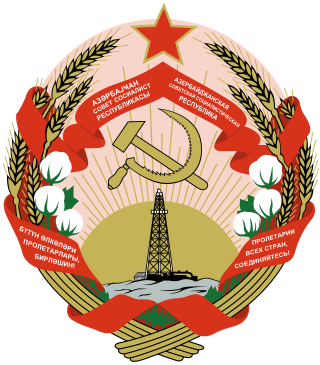
The emblem of the Azerbaijan Soviet Socialist Republic was adopted in 1937 by the government of the Azerbaijan Soviet Socialist Republic. The style is based on the emblem of the Soviet Union.

The coat of arms of the Kazakh Soviet Socialist Republic was adopted on 26 March 1937 by the government of the Kazakh Soviet Socialist Republic. The coat of arms is based on the coat of arms of the Soviet Union.

The emblem of the Kirghiz Soviet Socialist Republic was adopted on 23 March 1937 by the government of the Kirghiz Soviet Socialist Republic. The coat of arms is based on the coat of arms of the Soviet Union. It shows symbols of agriculture on a backdrop of the Ala-Too mountain ranges, surrounded by a frame of folk art of the Kyrgyz people. The red star was added in 1948. The rising sun stands for the future of the Kyrgyz nation, the star as well as the hammer and sickle for the victory of communism and the "worldwide socialist community of states".

The State Emblem of the Tajik Soviet Socialist Republic was adopted on 1 March 1937 by the government of the Tajik Soviet Socialist Republic. The emblem is based on the State Emblem of the Soviet Union. It shows symbols of agriculture. The red star is prominently featured with a small hammer and sickle within it. The rising sun stands for the future of the Tajik nation, and the star as well as the hammer and sickle for the victory of communism and the "world-wide socialist community of states". The emblem was replaced with the new emblem in 1992, which uses a similar design to the Soviet one. It was, however, was replacing the red banner with the current national flag, the big red star was replaced by the mountains, represents Pamir, the Samanid dynasty crown, and added the Quran book at below. It represents Islam as the official religion.

The Emblem of the Uzbek Soviet Socialist Republic was adopted on 14 February 1937 by the government of the Uzbek Soviet Socialist Republic. The emblem is based on the emblem of the Soviet Union. It shows symbols of agriculture and heavy industry (hammer). The rising sun over a map of the Soviet Central Asia symbolizes the future of this region, while the five pointed red star stands for the "socialist revolution on all five continents".

The coat of arms of the Moldavian Soviet Socialist Republic was adopted on 10 February 1941 by the government of the Moldavian Soviet Socialist Republic. The coat of arms is based on the coat of arms of the Soviet Union. It shows symbols of agriculture, an outer rim featuring wheat, corn, grapes and clover. The red banner bears the Soviet Union state motto in both the Romanian language and the Russian language. In Romanian, it was initially "Пролетарь дин тоате цэриле, униць-вэ!"; then, from the 1950s "Пролетарь дин тоате цэриле, уници-вэ!". Both are written in the Latin alphabet as "Proletari din toate țările, uniți-vă!". The acronym MSSR is shown only in Romanian in Moldovan Cyrillic ("РССМ"). The emblem was replaced on 3 November 1990 by the present coat of arms of Moldova. Currently, the unrecognized breakaway state of Transnistria uses a similar state emblem.
The emblem of the Moldavian Autonomous Soviet Socialist Republic was an official emblem used in the Soviet Union in the early 20th century. It had underwent a number of changes over time.

The State Emblem of the Soviet Union was the official symbol of the Union of Soviet Socialist Republics adopted in 1923 and used until the dissolution of the state in 1991. Although it technically is an emblem rather than a coat of arms, since it does not follow traditional heraldic rules, in Russian it is called герб, the word used for a traditional coat of arms.

The Emblem of Karakalpakstan is one of the official symbols of Karakalpakstan, an autonomous republic within Uzbekistan. It was approved on April 9, 1993. The coat of arms was developed from a sketch by Karakalpak artist Jollybai Izentaev based on the emblem of Uzbekistan.
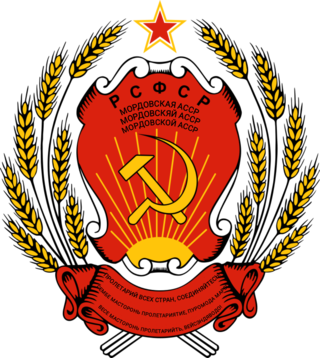
The national emblem of the Mordovian Autonomous Soviet Socialist Republic was adopted in 1937 by the government of the Mordovian Autonomous Soviet Socialist Republic. The emblem is identical to the emblem of the Russian Soviet Federative Socialist Republic.
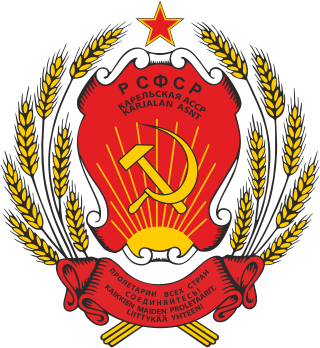
The national emblem of the Karelian Autonomous Soviet Socialist Republic was adopted in 1937 by the government of the Karelian Autonomous Soviet Socialist Republic. The emblem is identical to the emblem of the Russian Soviet Federative Socialist Republic.
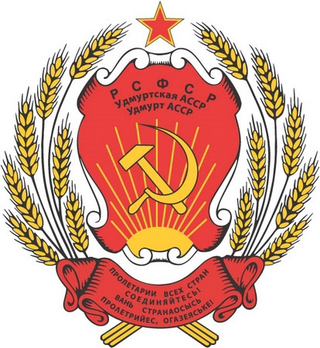
The National Emblem of the Udmurt Autonomous Soviet Socialist Republic was adopted in 1937 by the government of the Udmurt Autonomous Soviet Socialist Republic. The emblem is identical to the Emblem of the Russian Soviet Federative Socialist Republic.
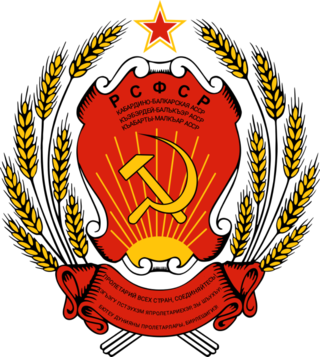
The national emblem of the Kabardino-Balkarian Autonomous Soviet Socialist Republic was adopted in 1937 by the government of the Kabardino-Balkarian Autonomous Soviet Socialist Republic. The emblem is identical to the emblem of the Russian Soviet Federative Socialist Republic.

The national emblem of the Tatar Autonomous Soviet Socialist Republic was adopted in 1937 by the government of the Tatar Autonomous Soviet Socialist Republic. The emblem is identical to the emblem of the Russian Soviet Federative Socialist Republic.
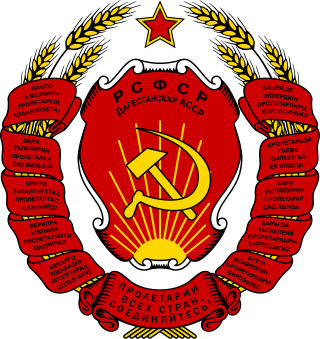
The national emblem of the Dagestan Autonomous Soviet Socialist Republic was adopted in 1937 by the government of the Dagestan Autonomous Soviet Socialist Republic. The emblem is almost identical to the emblem of the Russian Soviet Federative Socialist Republic except the number of wheat, the banner's length and it shows other languages apart from Russian.

The national emblem of the Abkhaz Autonomous Soviet Socialist Republic was adopted in 1937 by the government of the Abkhaz Autonomous Soviet Socialist Republic. The emblem is identical to the emblem of the Georgian Soviet Socialist Republic.

The national emblem of the Adjarian Autonomous Soviet Socialist Republic was adopted in 1922 by the government of the Adjarian Autonomous Soviet Socialist Republic. The emblem is identical to the emblem of the Georgian Soviet Socialist Republic.

The emblem of the Crimean Autonomous Soviet Socialist Republic was adopted in 1921 by the government of the Crimean Autonomous Soviet Socialist Republic. The emblem was similar to the emblem of the Russian Soviet Federative Socialist Republic.

The coat of arms of the Sakha Republic, in the Russian Federation, is an official symbol of the Sakha Republic, alongside the flag and the national anthem of the Sakha Republic. The coat of arms consists of a circle, in the center of which is a red silhouette of a rider on horseback holding a banner, based on the prehistoric petroglyphs of the "Shishkin pisanitsa", against a white sun background. The central image is framed with a traditional Sakha ornament in the form of seven rhombic crystal-like figures and the inscriptions "Республика Саха (Якутия) • Саха Өрөспүүбүлүкэтэ". This coat of arms has been used officially since 26 December 1992.

